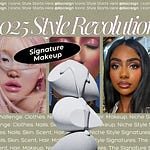For as long as modern American society has drawn deep trenches of class distinction, luxury has been synonymous with exclusivity, quality, and craftsmanship—all tied together with the bow of an exuberant price tag. Niche experiences and products were reserved for those who could afford them and only other aware by those who served this elite. But as media expanded over decades—from magazines to television, film, music, and now social media—it granted unprecedented access to the lavish comforts of the upper class. Products once emblematic of a particular tax bracket trickled into the hands of anyone with cash, regardless of whether it came from a debit card or a Klarna charge.
The balanced ratio of luxury brands prioritizing high-spending clients alongside aspirational buyers in the 2000s became completely unbalanced post-COVID. As brands sought to recoup financial losses from the global economic fallout of the pandemic, they faced rising fast fashion competition and the battle for consumer attention. In response, many luxury houses sacrificed exclusivity, flooding the general market with products, cutting corners on quality control, using cheap materials like polyester, and outsourcing production to factories with poor working conditions and low wages.
Consumers—whether champions of high or low fashion—have grown increasingly aware of the disparity between the quality of their clothing and its price tags. This awareness sets the stage for a significant pendulum swing in 2025's style zeitgeist. Add social media fatigue, general distrust in authority, environmental upheavals, and economic challenges, and it’s clear that cultural shifts are on the horizon.
Prediction 1: Shifting Status Signals – Personal Style, Maximalism, and Sustainability
Personal Style
After years of dull tones and cookie-cutter design aesthetics fit only for corporate offices, the tide is turning toward quality elements that signal status while potentially benefiting the environment. Whether this is an elite-driven move to separate themselves from "wannabe" old-money enthusiasts or simply a reaction to years of style homogeneity, personal style is poised to be 2025’s hottest “trend.”
Maximalism
A close cousin to personal style, maximalism is primed for its resurgence. The concept of "more" has always been tied to wealth, so it’s no surprise that after years of minimalism's widespread appeal, maximalism is next up to bat.
While I love its lack of rigid rules, collective maximalism could veer into overconsumption as individuals attempt to differentiate themselves—teetering on the edge of an aesthetic fit for an 8th-grade tacky day. (More on this in Prediction #3.)
Sustainability
The last potential shift in status signals could genuinely benefit the environment. Polyester’s affordability has now become a synonym for its lack of quality (seriously, my Forever 21 high school clothes hold up better than today’s fast fashion). Even Shein’s die-hard fans are questioning the poor construction quality, short lifespan, and exploitative labor conditions.
Interestingly, the critique extends to luxury brands like Dior and Chanel, once known for craftsmanship but now guilty of similar shortcuts. In response, consumers are gravitating toward luxury’s original definition: quality clothing meant to last, with vintage pieces in particularly high demand.
Natural fibers are leading the charge, driven by increasing awareness of environmental damage caused by synthetic materials. However, a word of caution: "natural" doesn’t always mean "ethical." Exploitation of agricultural workers and animals in cotton and wool production remains a critical concern.
Prediction 2: A Surge in Domestically Made Clothing
As the U.S. braces for a new administration and its proposed tariffs, domestic production might see a revival. In the early 1990s, 90% of American clothing was made domestically. After NAFTA in 1992, that number plummeted as jobs and machinery were sent overseas for cheaper labor.
Despite the outsourcing, the U.S. retained its agricultural resources—cotton, flax, wool—which often went unused as the demand for domestic textiles dwindled. However, since the mid-2010s, movements to revitalize the American textile industry have gained momentum, aiming to transform agricultural waste into quality, U.S.-made textiles and clothing.
Impending tariffs and economic uncertainty could push the U.S. to rely more heavily on its own resources. Still, the capitalist pursuit of profit raises a lingering question: Will "national security" outweigh corporate dependence on foreign labor?
Prediction 3: The Rise of a Maximalist Counterculture
Out of the loungewear era comes a mass counterculture poised to reject neutrality and embrace expression. Minimalist aesthetics like Quiet Luxury birthed subcultures such as "old money," "clean girl," and "vanilla girl," reflecting a post-pandemic craving for simplicity and predictability.
But maximalism is here to disrupt the calm. Against a backdrop of limited economic mobility, human rights restrictions, and environmental crises, fashion will become a form of rebellion. Expect bold layering, vibrant colors, mismatched patterns, and audacious pairings—an antidote to the cyclical nostalgia of the past 5 years.
As we step into 2025, the fashion landscape is brimming with potential for meaningful change. From the resurgence of personal style and maximalism to a renewed focus on quality and sustainability, this year could redefine status, consumption, and creativity. Whether through the rebirth of domestic manufacturing or bold countercultural movements, one thing is clear: fashion will continue to be a mirror of our times, reflecting the challenges we face and the resilience we embody. So, the question isn’t whether change is coming—it’s how we’ll choose to wear it.
xoxo,
If you enjoyed today’s post consider supporting the Style Society community by:
Subscribing and Becoming a Certified Fabric Snob
Liking & commenting, and sharing this post with someone who would enjoy it
Downloading The Style Bible, Your Custom Guide to Iconic Style
Gifting Me A Lavender Chai Latte 🪻



















Share this post